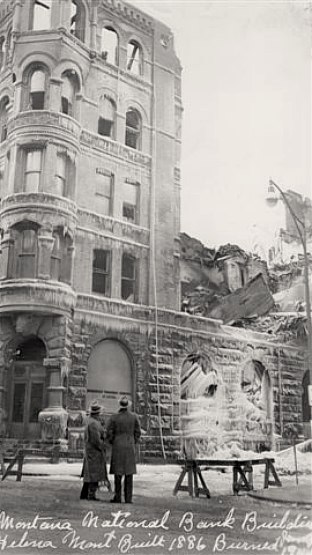|
|

|
Last Chance
Gulch was the name of the actual gulch in which gold was discovered
in 1864. The thoroughfare which was built down the Gulch was
originally named Main Street; it remained that way for some
85 years, until July 20 1953, when acting Helena Mayor Dr. Amos
R. Little, Jr. signed an ordinance officially changing the name
of Main Street to Last Chance Gulch. Both names are still used
locally for what was once the grand thoroughfare of Helena's
business district.
Last Chance
Gulch meanders as it does because it was originally routed between
mining claims; it was not designed that way to lower fatalities
from stray bullets, as some promotional literature has claimed.
The
images in this section are arranged so that the viewer will
start near the southern end of Last Chance Gulch, and will move
north. The images of each stretch of the street -- like "Broadway
to Sixth" -- will be arranged in chronological order, as
nearly as possible.
|


|
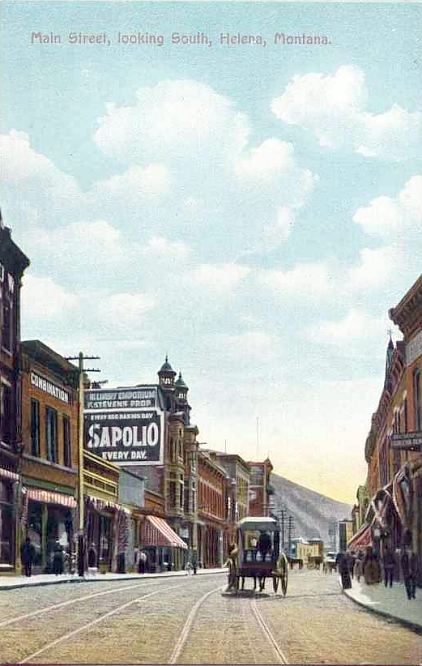
| Last
Chance Gulch, 1890s, looking south from Broadway. Advertised on
the side of the Novelty Block (now demolished) is Sapolio Soap.
Sapolio, started in 1868 in New York City by Enoch Morgan &
Sons, was a pioneering company in the use of mass-marketing, hence
this sign. The brand is still in existence today -- in Peru. The
Sapolio sign was eventually replaced by one for Coca-Cola, which
remained on the building until it was demolished in the 1970s. |
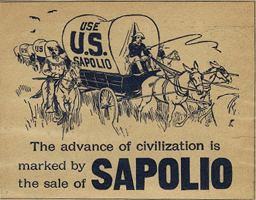

|
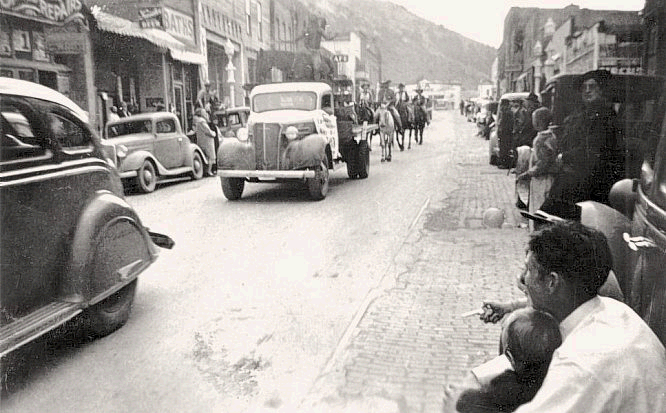
| 1937
Vigilante Parade on South Main. This photo is courtesy of Carol
Lynch Synness, whose family operated the New Cash Market at 58
South Main. She is being held here by her uncle, John Lynch. Photo
by Ruth Lynch. THE WES AND CAROL
SYNNESS COLLECTION |

|
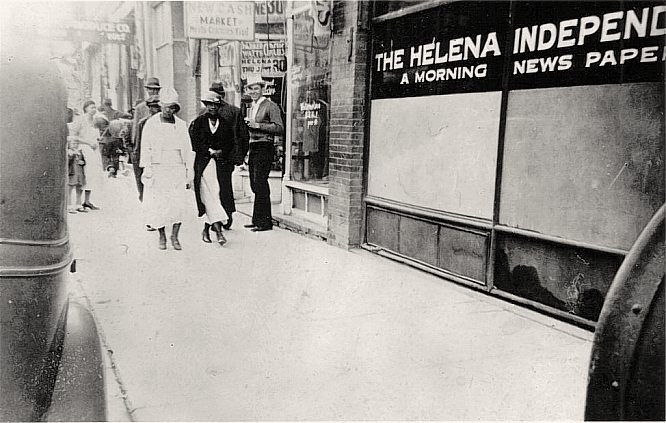
| The New Cash
Market, 58 S. Main, 1937. The New Cash was located next door to
the Helena Independent newspaper. THE
WES AND CAROL SYNNESS COLLECTION |
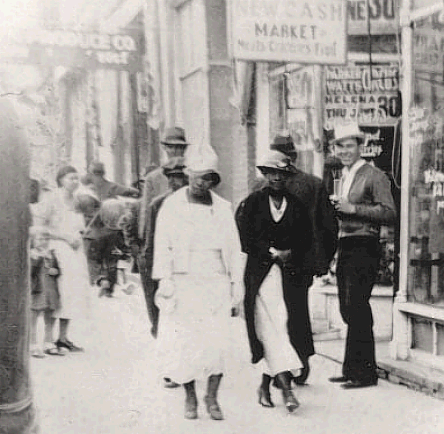
| New Cash
Market, 1937 - detailed view. The lady holding the balloon is
Gwendolyn Lynch. The little girl with her is her daughter Kay
Lynch. THE WES AND CAROL SYNNESS
COLLECTION |

|
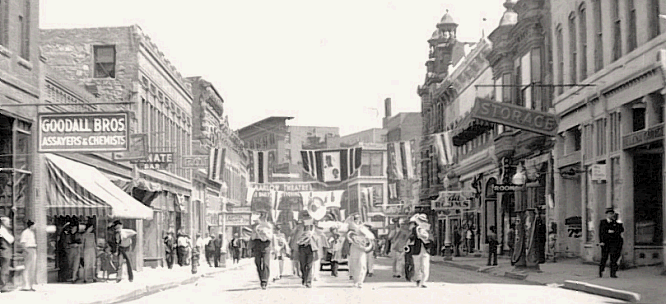
|
A
parade going south on Main St., 1939. THE
WES AND CAROL SYNNESS COLLECTION
|
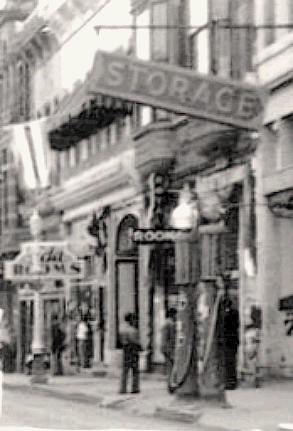
| A detail
from the above image, showing gasoline pumps and rooming houses
on the east side of South Main. |

|
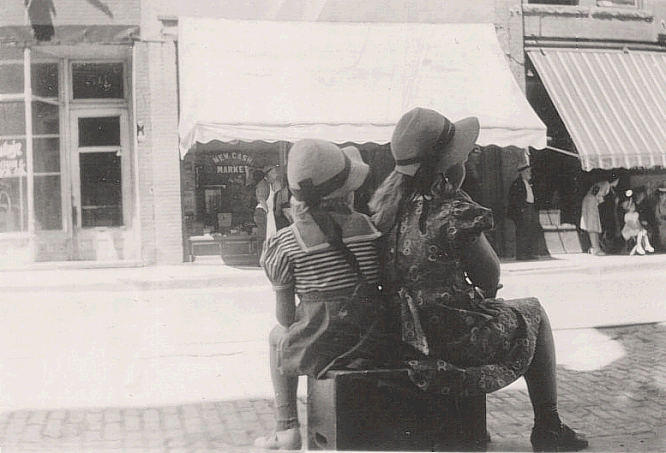
| Sisters Carol
and Kay Lynch watching the parade, 1939. Across the street is
the New Cash Market, which the Lynch family operated. The man
wearing the apron is Leonard Franks, a partner in the business.
THE WES AND CAROL SYNNESS COLLECTION
|
|
|
|
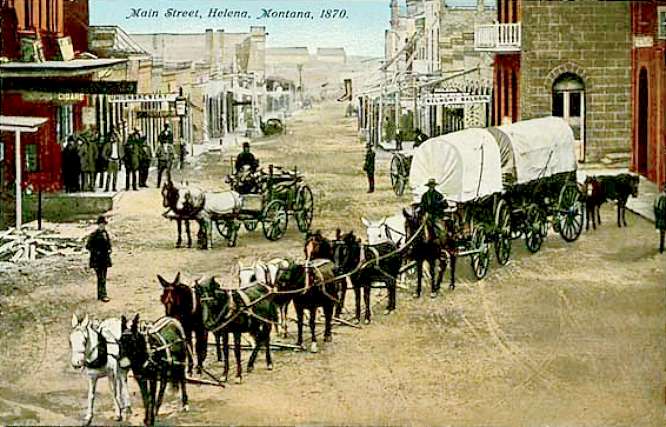
| This ca.
1910 postcard shows one of two similar posed 1870 photographs
of Main near the foot of Grand St. It's reasonable to assume that
the version below was taken shortly after this one, because a
larger crowd has gathered. |
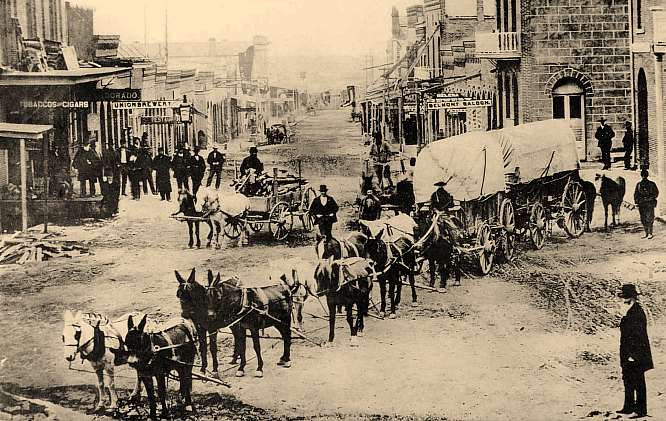

|
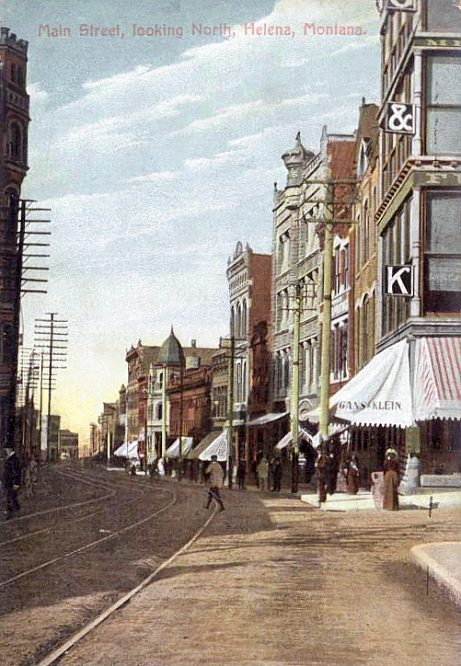
|
A
frequently-photgraphed corner for over a century -- Last Chance
Gulch looking north from Broadway, ca. 1890.
On the corner
is the Gans (sometimes "Ganz") and Klein clothing
store...
|
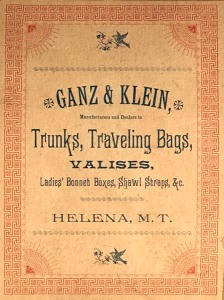
Ganz & Klein
trunk label, before 1889.

|
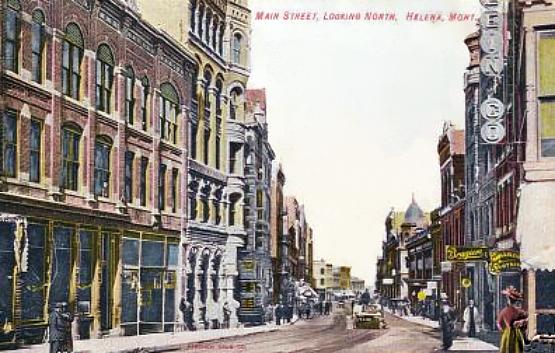
| A ca.1900
view from the same corner. The next few
views will show the evolution of this corner up to the 1960s,
after which we'll resume the chronological progression. |

|

Ca. 1915, showing
the new seven-story Placer Hotel.

|
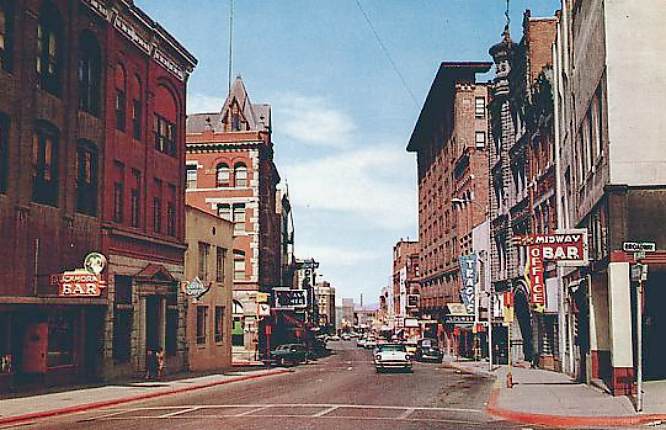
Looking north
from Broadway, 1950s.

|
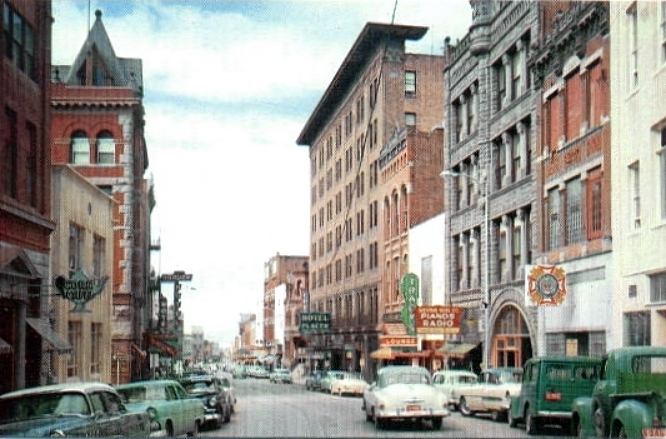
| Last Chance
Gulch, 1950s, looking north from Broadway. The gray granite
building on the right is the 1888 Atlas Block, |

|
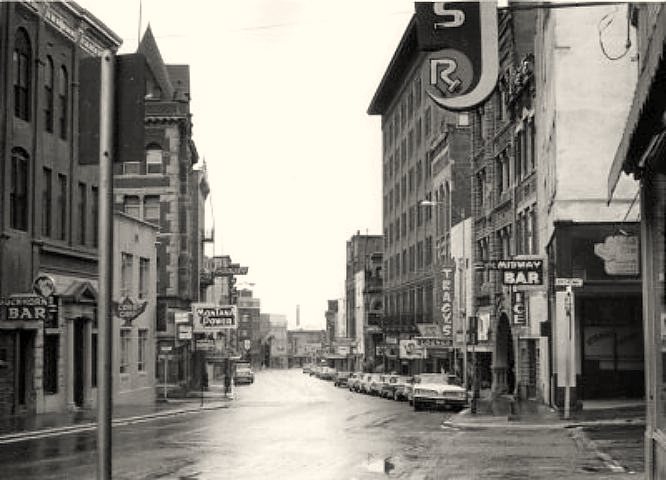
Looking north
from Broadway, 1960s.

|
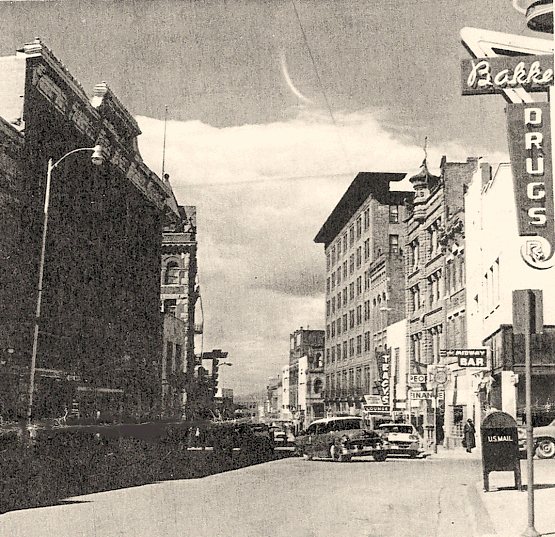
|
This
view taken about 1960 by Lee Goodspeed (1950-2004) THE
COLLECTION OF NANCY GOODSPEED
|

|
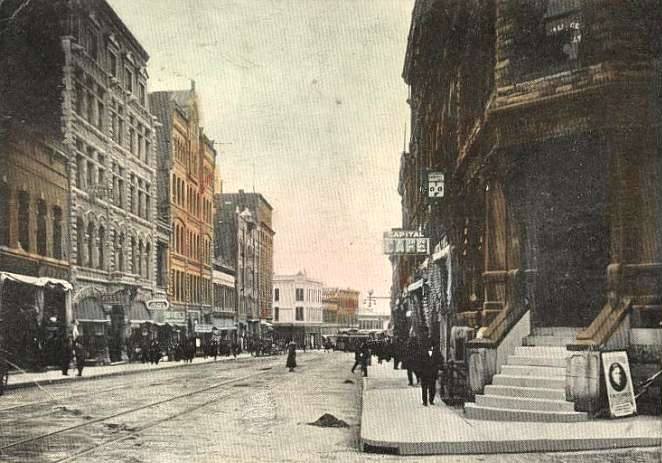
| Last
Chance Gulch, about 1900, looking north from Grand St. Nearly
all the buildings on the left were destroyed in the fire of July
16, 1928. On the right is the doorway of Samuel T. Hauser's 1886
First National Bank, long known as the Securities Building. |
|
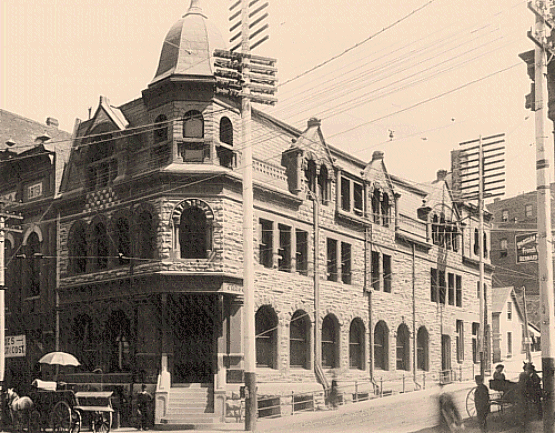
|
Hauser's
bank in the 1890s, and as it appears today...
|
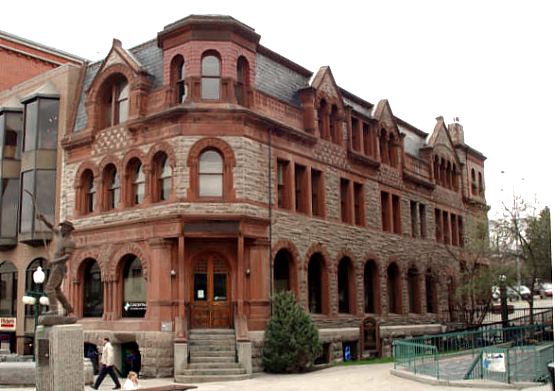

|
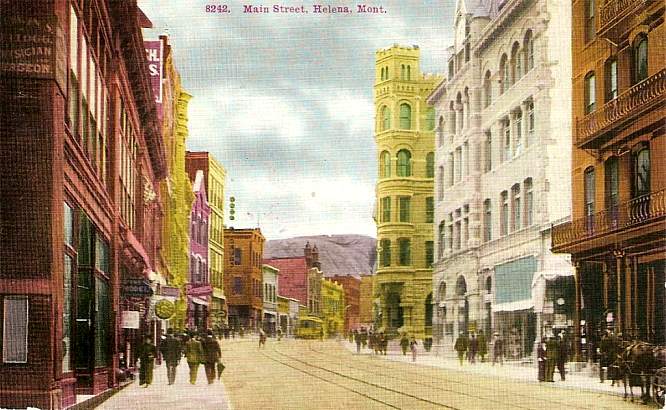
|
A
fancifully-tinted ca. 1900 view of Last Chance Gulch, looking
south from Grand St. Prominent on the right is the (white)
1889 Merchants National Bank building, and the (yellow) 1883
Montana National Bank building.
|
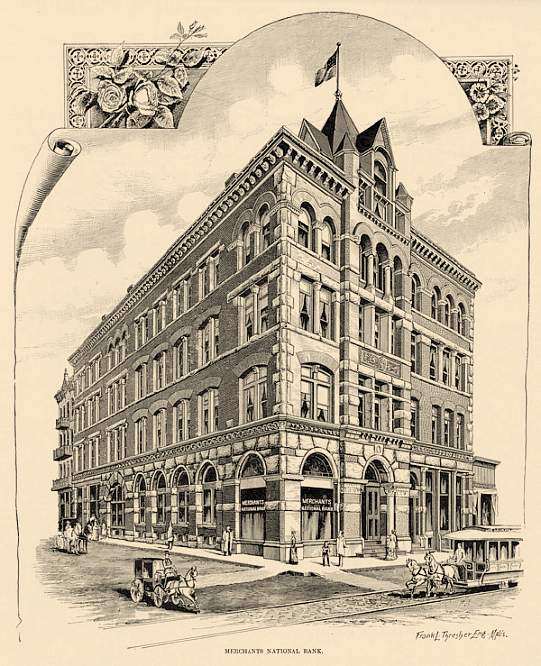
1890 illustration
of the Merchant's National Bank building.

|
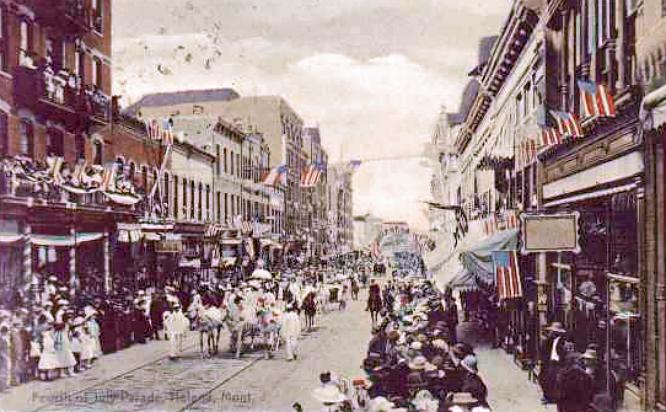
Fourth of July
Parade on Last Chance Gulch, looking north frrom Grand St., ca. 1890

|
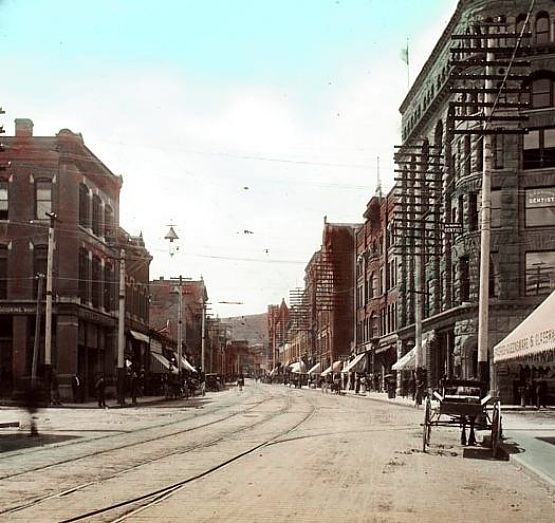
|
Last
Chance Gulch, 1890s, looking south from 6th Ave.
|

|
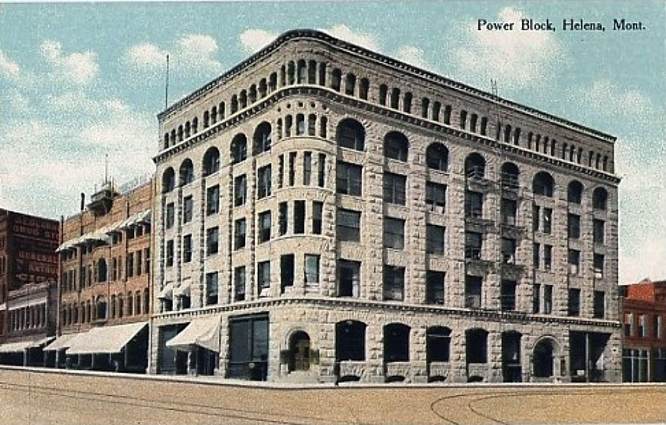
| Built to
last in 1889 by magnate Thomas C. Power, The Power Block still
presides over the intersection of "Sixth and Main" in
downtown Helena. |
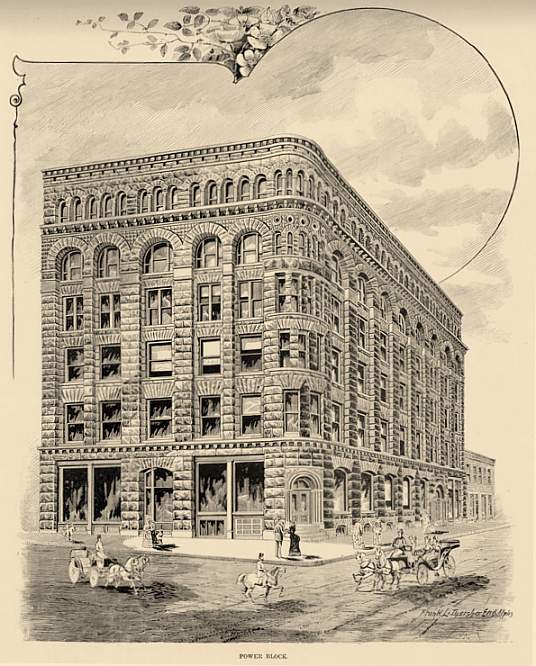
1890 illustration
of the Power Block. in 1884, a feed stable occupied the site.
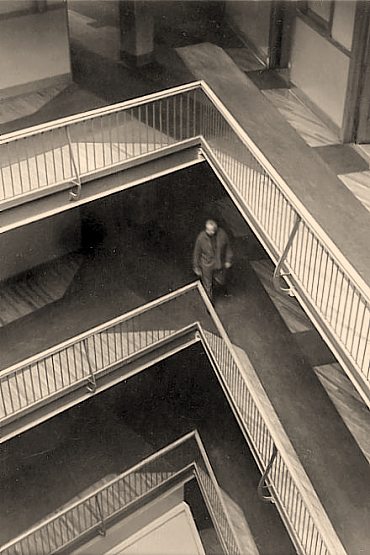
Interior of the
Power Block, 1970.

|
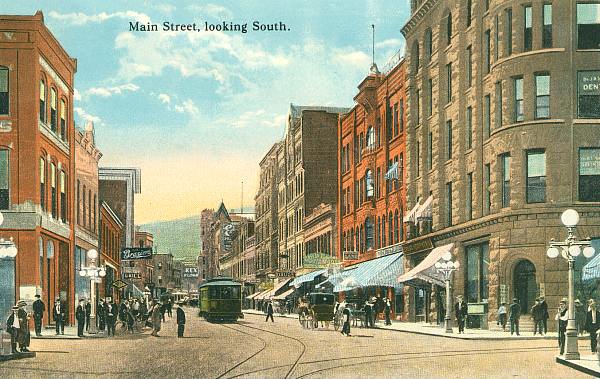
Last
Chance Gulch, ca 1915, looking south across 6th Avenue.

|
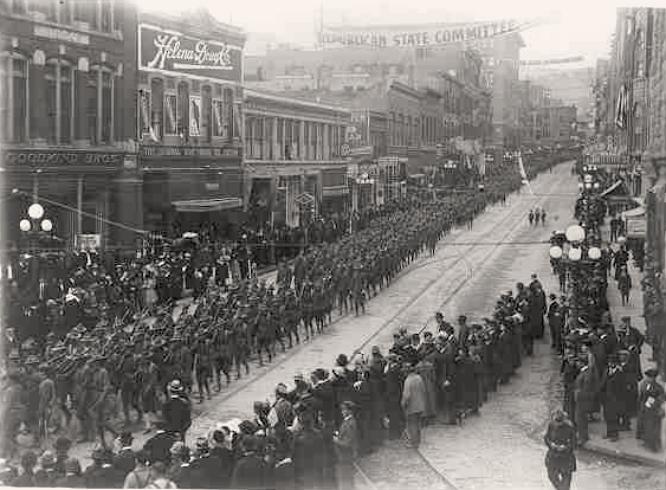
A
WWI-era parade on Last Chance Gulch, looking south from Sixth
Ave. If anyone can date this image more precisely, please send
me an e-mail.
|

|
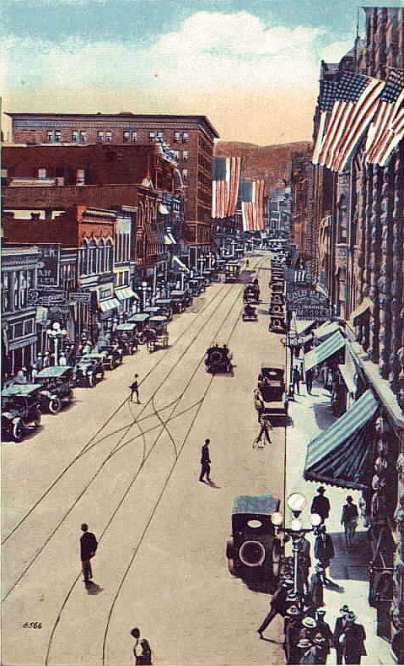
Last Chance Gulch,
1920s, looking south from 6th Avenue.

|
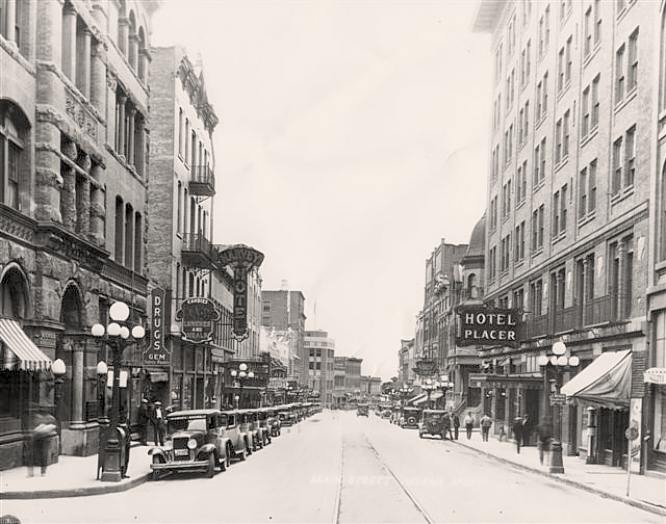
Last Chance Gulch,
1930s, looking north from Edwards St. THE
DAVID HULL COLLECTION

|
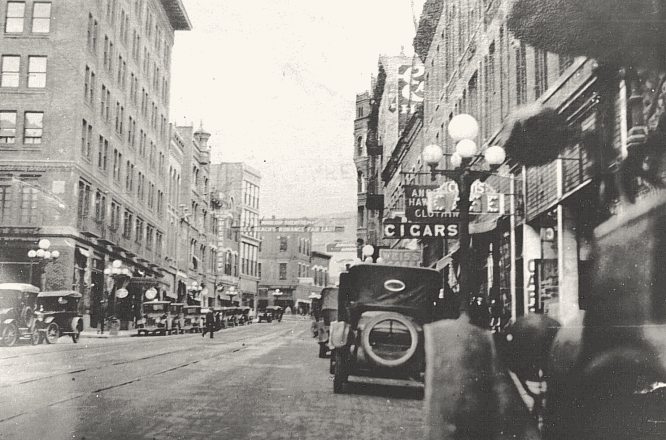
Last Chance Gulch,
looking south from near Grand St., 1922.
THE WES AND CAROL SYNNESS COLLECTION

|
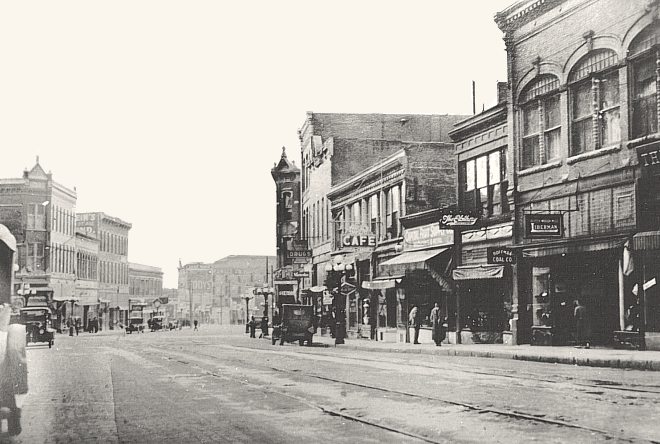
| Last Chance
Gulch, looking north across 6th Ave., 1920s. Prominent on the
right is the 1880s Beveredge Block. Many will recall Jacoby's
Store for Men and the Thistlewaite Shoe Co. in this location.
THE WES AND CAROL SYNNESS COLLECTION
|
|
|
|
Many Helena
Baby-Boomers will remember, as I do, placing their young feet
in Thistlewaite's shoe-fitting fluoroscope, a hazardous sales
gimmick which was banned from the market by the 1960s.
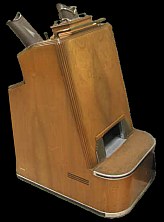
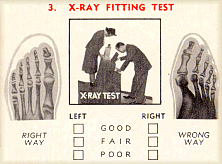
|
|
|
|


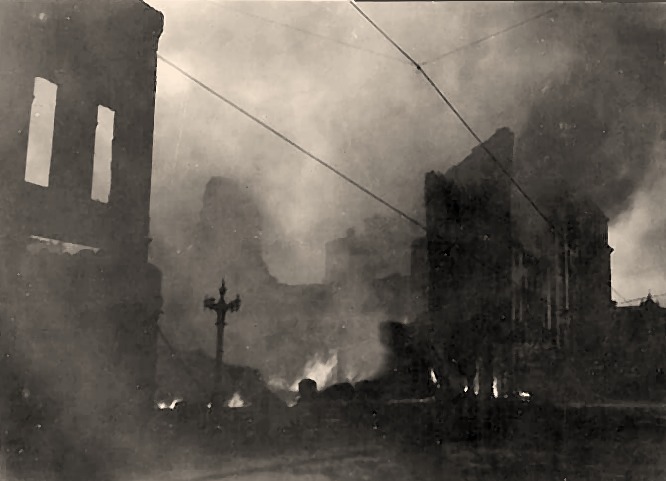
|
|
|
In
the early-morning hours of July 16 1928, flames erupted from
28 N. Main St., the building which housed the Curtis Cafe and
the Maverick Pool Hall. The rapidly-spreading fire was discovered
and reported at 2:00am by Johnny Bukowitz, a printer at the
Helena Independent newspaper, who happened to be passing the
cafe.
No
sooner had the Helena Fire Department responded to the blaze
than a torrential hour-long rainstorm began, hampering firefighting
efforts but wetting nearby roofs, preventing an even greater
catastrophe. Roomers in the adjacent buildings fled into the
streets, where they were soon soaked to the skin by the downpour.
The storm brought with it shifting winds, which threatened to
carry embers in every direction. Frequent lightening bolts illuminated
the surreal scene.
In
two hours time, the fire was completely out of control, and
had spread north destroying numerous businesses. It also crossed
over to the east side of Main St., damaging several buildings.
Firefighters began concentrating their efforts on saving buildings
on Sixth Avenue and the east side of Main. Shop owners and other
businessmen hurriedly carried goods, equipment and records from
threatened buildings. Explosions were heard when the blaze touched
off chemicals stored at the Budd-Fisher Drug Co. The Western
Union lines were severed by the fire.
By
6:00am the fire was brought under control, but had destroyed
several large commercial buildings housing dozens of businesses.
The Granite, Bailey, Gold, and New York Store blocks were reduced
to rubble; the Power Block, the A. P. Curtin Block, the Pittsburgh
Block, and several other buildings were damaged.
The
blaze was far beyond the power of the Helena Fire Department
to cope with; water pressure was adequate, but too few hoses
and too few men could be brought to bear.
|
|
|
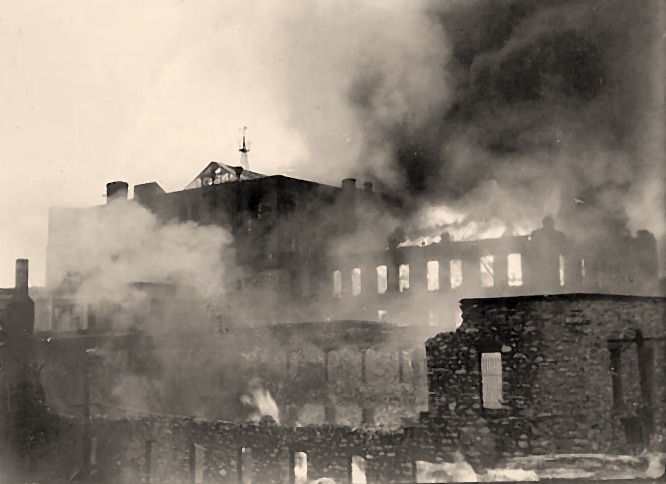
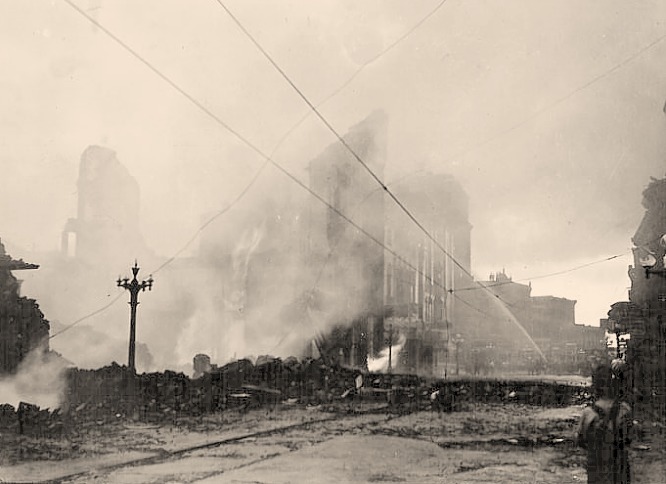
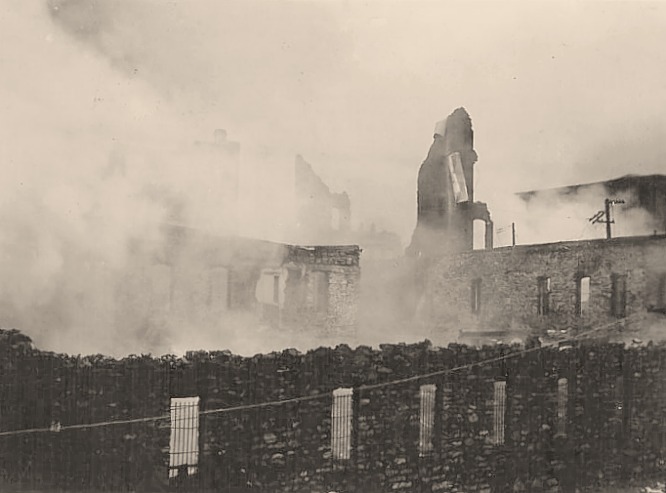

|
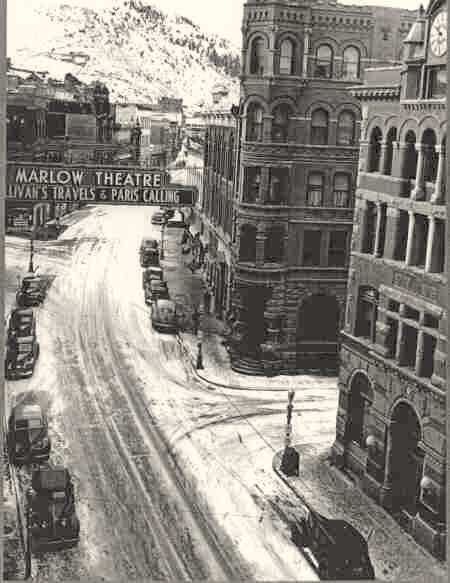
Last Chance Gulch,
1942, looking south across Edwards St. (right) and Broadway (left).

MONTANA NATIONAL
BANK FIRE - 1944
|
|
|
|
Two views of the
January 11, 1944 fire that destroyed the Montana National Bank building.
THE DAVID HULL COLLECTION

|
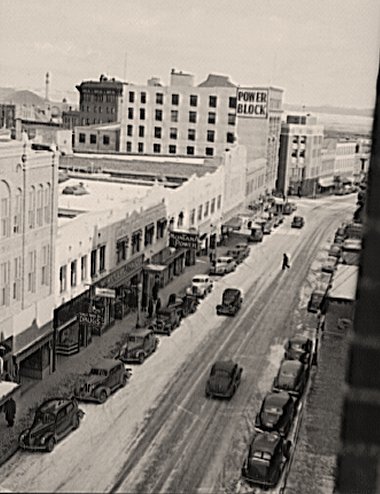
Looking north,
1942. This view shows the post-fire buildings.

|
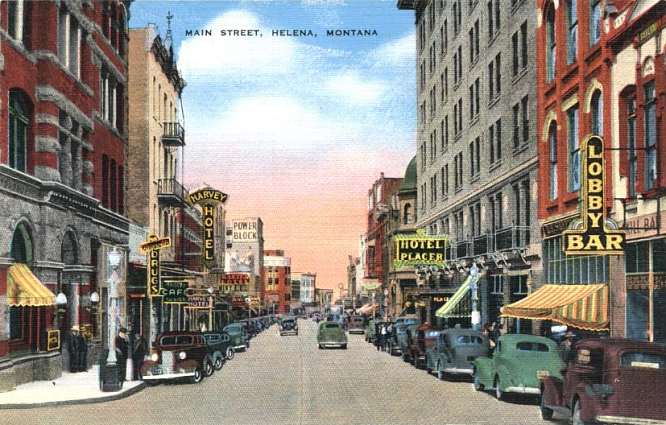
Last Chance Gulch,
1940s, looking north from Edwards St.

|
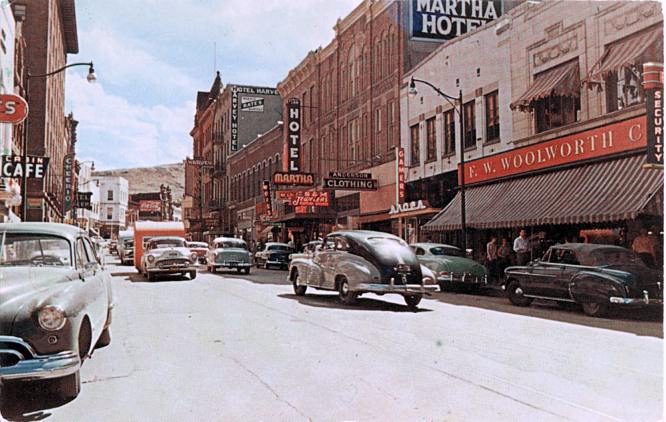
Last Chance Gulch,
looking south, early 1950s.

|
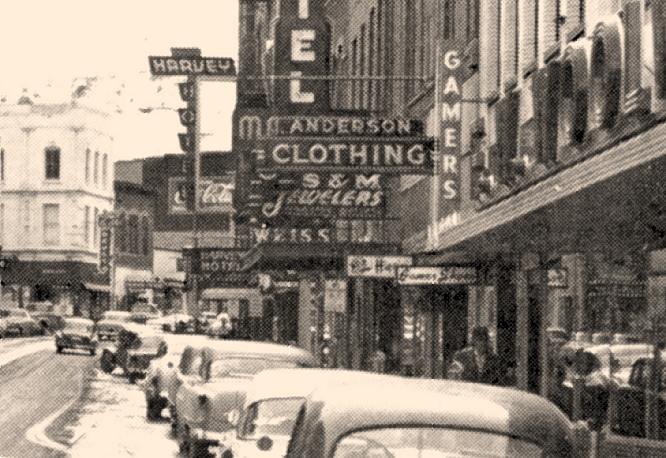
|
West
side of Last Chance Gulch, looking south, about 1954. COLLECTION
OF ED MCKNIGHT
|

|
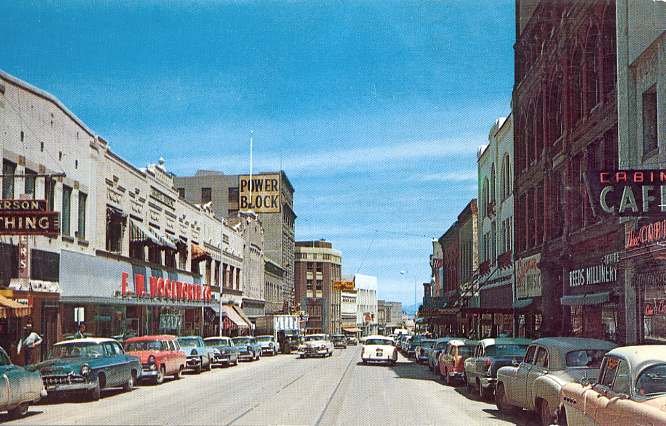
|
N. Last
Chance Gulch, looking north, mid-1950s. Just look at all that
beautiful two-way traffic and the abundance of stores. Notice
that Woolworth's had replaced their striped canvas awning and
classic red and gold sign with a charmless aluminum and plastic
overhang. On the right is the Cabin Cafe (formerly the Eddy
Cafe). Although the Cabin Cafe advertised "Chicken Dinners"
on their matchbooks, what yours truly remembers most are their
breaded veal cutlets -- with cream gravy, of course.
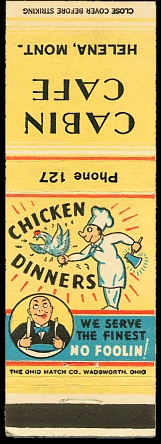
COLLECTION
OF KENNON BAIRD
|

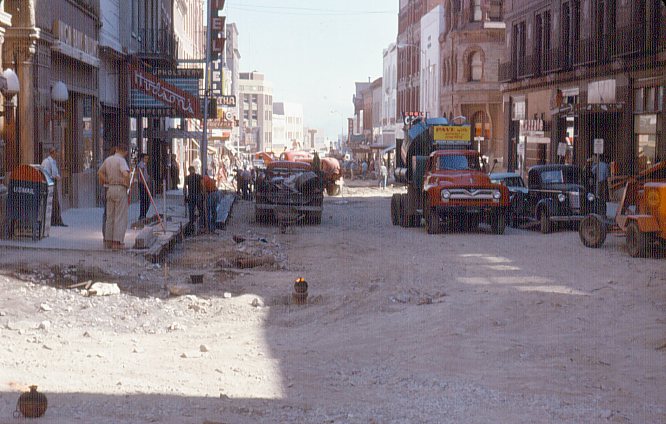
|
Looking
north from Edwards Street, 1958. This extensive asphalt repaving
and sewer repair project also removed the streetcar rails and
1905 brick paving.
Main Street
was first paved in 1892, with hot coal tar over a macadam base.
In 1905, the stretch between Cutler Street north to Helena Avenue
was paved with bricks.
In the above
photo, the man in khaki, with hands hips, is James Nelson. The
cement truck on the right is still in operation today. COURTESY
OF SCOTT NELSON - THE
BRIDGEWORKS CONSERVANCY
|

|
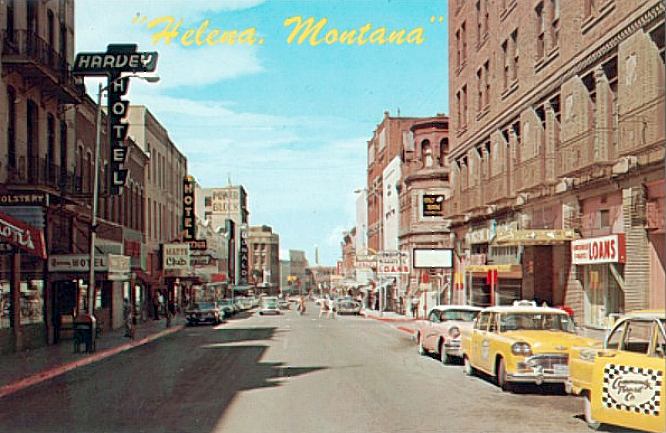
| Looking
north, ca. 1960. Many of the business on the left - the Martha
Hotel, Higgins Cigar Store, Matt's Club, etc. - were destroyed
by fire in the 1960s. |
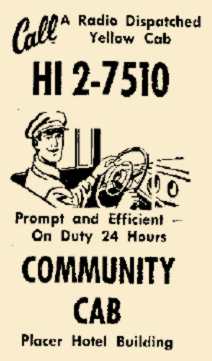
Community Cab
newspaper ad, 1960.

|
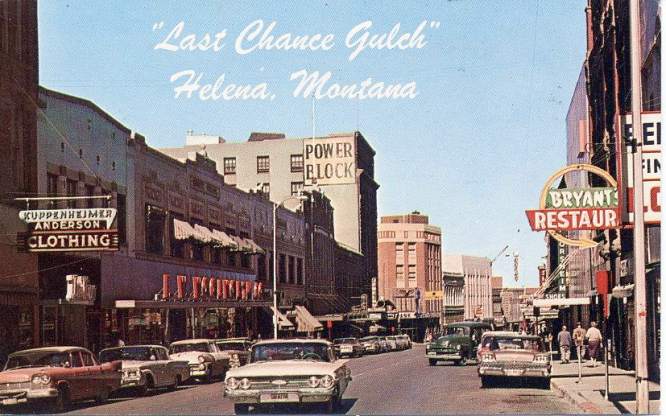
|
Last Chance
Gulch, ca. 1960, looking north toward 6th Avenue. The Cabin
Cafe was then Bryant's, and a prominent "Kuppenheimer"
had been added to the Anderson Clothing sign.
|

|
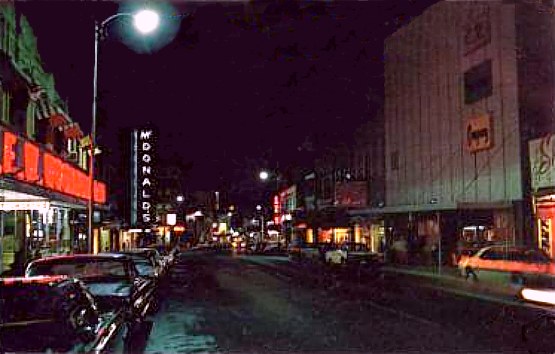
|
Last
Chance Gulch, early 1970s, looking north toward 6th Avenue.
The aluminum-sheathed strorefront on the right was the C. R.
Anthony Co., an Oklahoma-based retail chain.
|

|
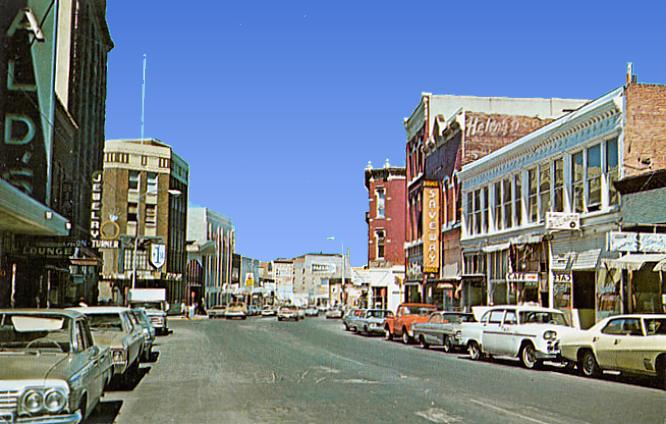
| An eary 1970s
view, looking north across 6th Avenue. All but one of the buildings
on the right (the tall Goodkind Building) were soon to be demolished
by the Urban Renewal Project. Does anyone else remember getting
hot nuts from Saveway Drug? |
|


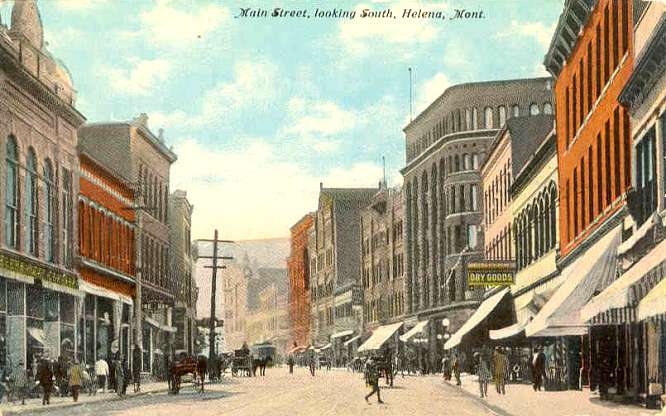
|
A
summer morning in the 300 block of Main St., circa 1900, looking
south across Sixth Avenue.
|

|
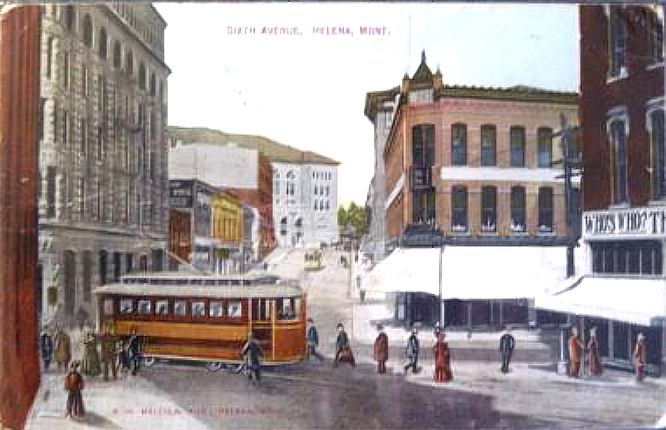
6th Ave. at Main,
looking west, 1909.

|
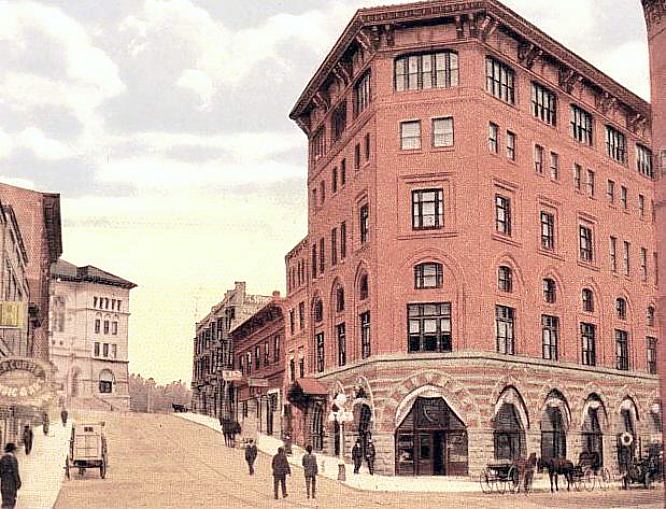
|
The second
Montana Club building, Sixth and Fuller, about 1915. Built in
1905 to replace the original 1893 building which was destroyed
by arson, the new Club was designed by noted architect Cass
Gilbert. On the left can be seen the sign for the A. P. Curitn
Music and Art store.
COURTESY OF BLAKE GARDINER
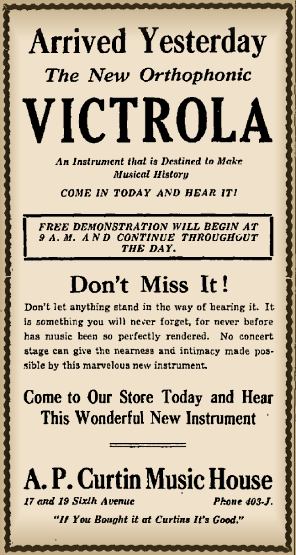
1925
Ad for the A. P. Curtin Music & Art store.
|

|
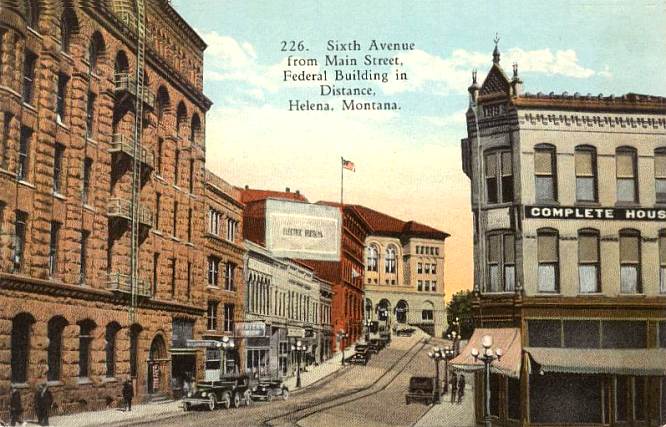
| 6th Avenue,
1920s, looking west from Last Chance Gulch. The building on the
right was demolished in the 1930s, making way for the First National
Bank building. Note the multi-globe streetlights; they would soon
be replaced by lights of a newer but less attractive design, as
seen in the next image... |

|
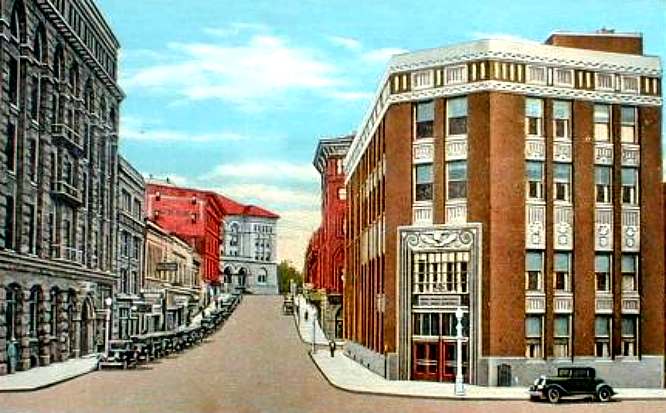
6th Avenue, 1930s,
looking west from Last Chance Gulch.

|
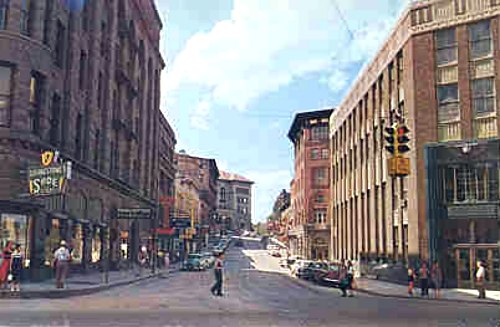
6th Avenue, 1950s,
looking west from Last Chance Gulch.

|
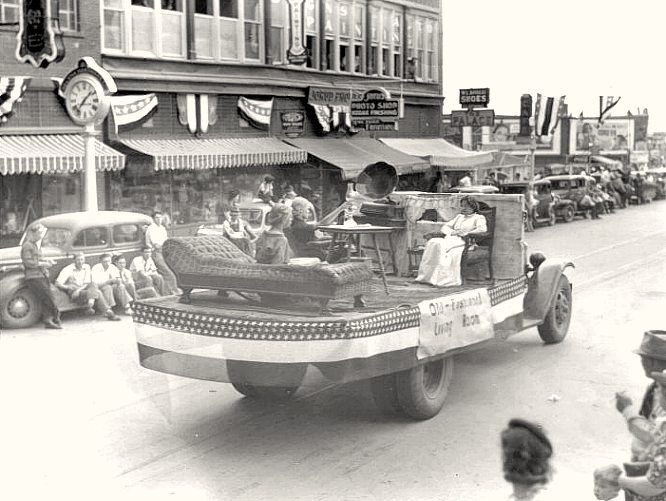
Vigilante Parade
float ("Old-Fashioned Living Room") 300 block of N. Main,
1937.
THE
WES AND CAROL SYNNESS COLLECTION

|
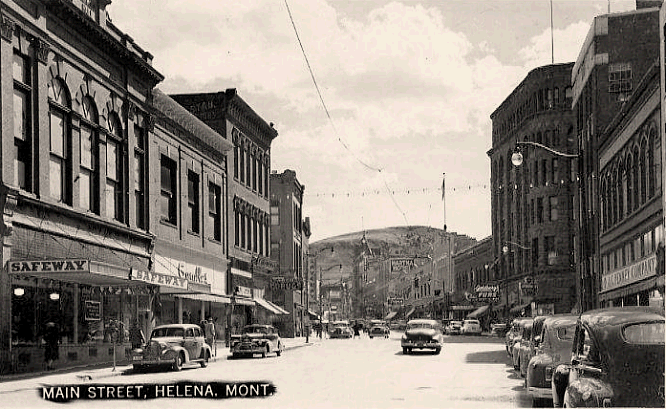
|
Last Chance
Gulch, late 1940s, looking south across 6th Avenue. The Safeway
market would soon move to the NE corner of Placer and Fuller,
and the Ben Franklin variety store would occupy the building
pictured here.
Also seen
on the left are Gamble's, Singer Sewing Machines, and Parchen
Drug. On the right are the First National Bank, the J. C. Penney
Co., and - in the Power Block - Goldberg's Furriers.
|

|
|
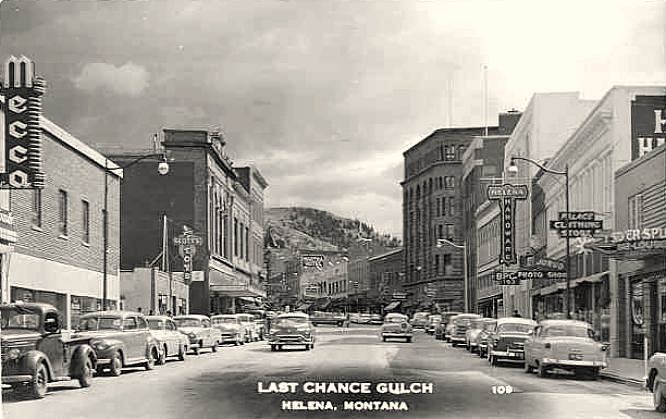
| 300 block
of N. Last Chance Gulch, 1950s, looking south. On the left are
the Mecca Cafe and Scott's Toys. On the right we see Helena Hardware,
the Elks Lodge (upstairs), Jorud Photo Shop, Palace Clothing,
and the Silver Spur Lounge (which later became O'Toole's). |

|
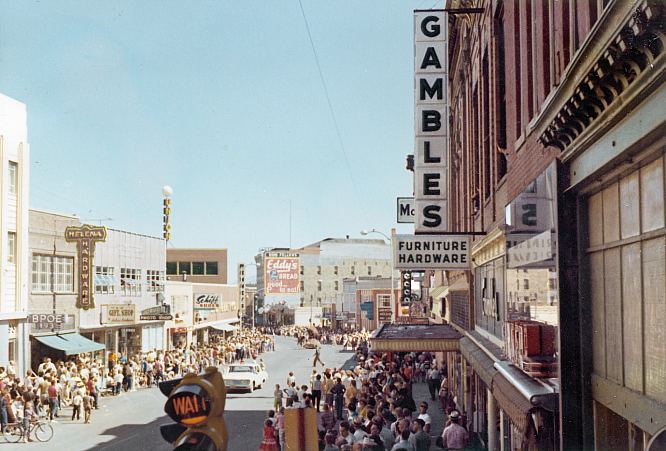
|
300
block of N. Last Chance Gulch looking north, Last Chance Stampede
Parade, 1963.
COURTESY OF KITTY ANN QUIGLEY
TAALER
|

|
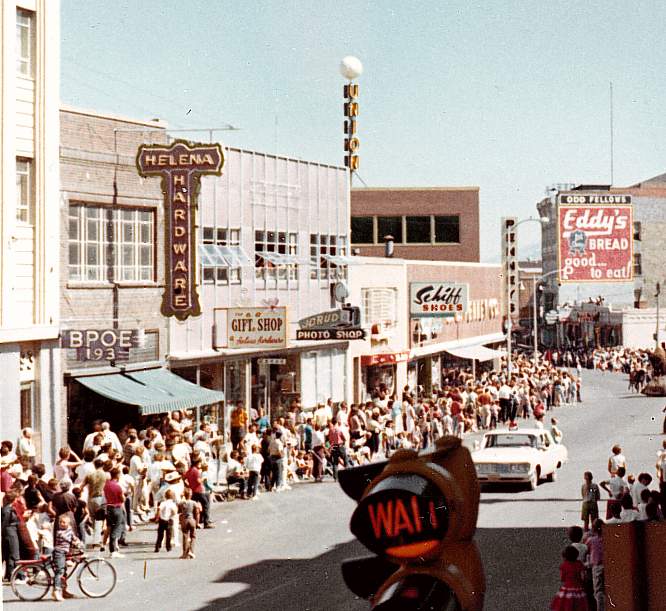
|
Enlarged
detail of previous image, 300 block of N. Last Chance Gulch,
1963.
COURTESY OF KITTY ANN QUIGLEY TAALER
|
|
|
|
At top center
is the Union Bank "Weatherball" sign, a white translucent
sphere which gave the latest weather forecast at night via colored-coded
lights inside. The bank's often-played radio jingle gave the
code, and permanently emplanted itself in the brains of all
Helenans:
"Union
Weatherball red as fire, the temperature is going higher.
Union Weatherball white as snow, down
the temperature will go.
When the Weatherball is green, no change
in temperature is foreseen.
Weatherball flashing night
or day, rain or snow is on the way."
|
|
|
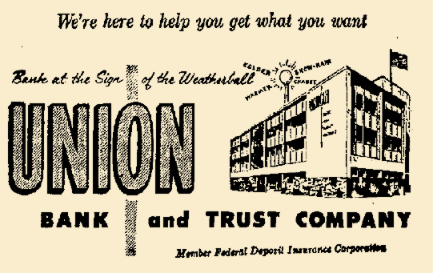
Union Bank newspaper ad featuring the Weatherball, 1960.

|
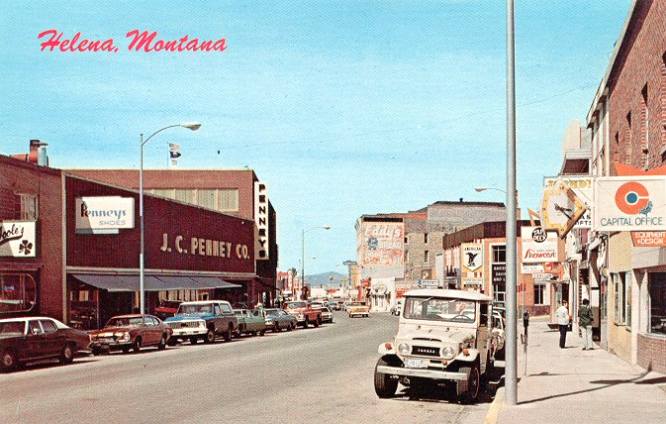
|
Postcard
view of Last Chance Gulch, 1970s, looking north. There may be
an uglier postcard of Helena, but I've never seen it.
The ca.
1963 J. C. Penny Co. store, the featureless box on the left,
was designed by Portland architects Edmondson & Kockendoerfer.
|

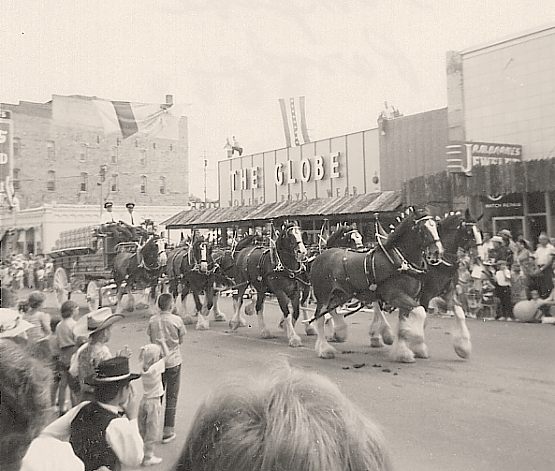
| Budweiser
Clydesdales, Last Chance Stampede Parade, 1964. Note the rough
pine-bark façades on The Globe Clothing Co. and Barnes
Jewelry. Many Helena businesses sported these during the Centennial
year of 1964. This had previously been done in 1949, during "Golden
Canyon Days", a celebration of the 60th year of Montana statehood.
COURTESY OF TOM KILMER |

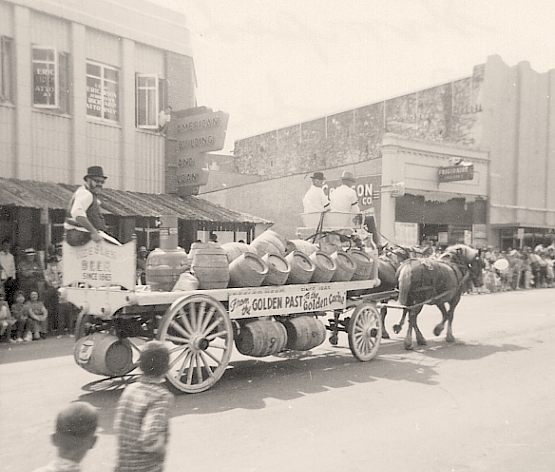
| Beer
wagon, Last Chance Stampede Parade, 1964. On the right is the
former Rio/Vigilante Theater building, still standing today. |

|
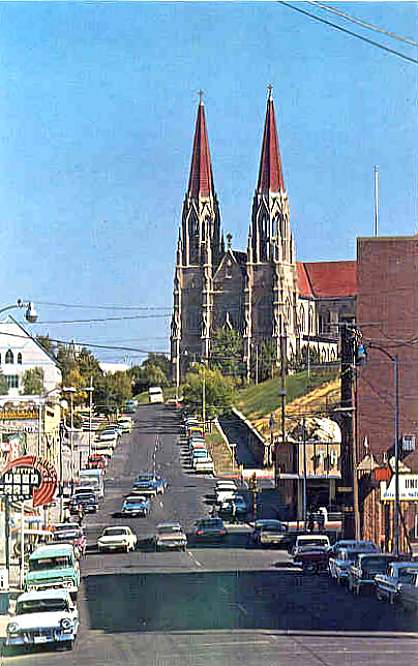
|
View
from W. Lawrence and Fuller, looking east across Main, 1964.
|

|
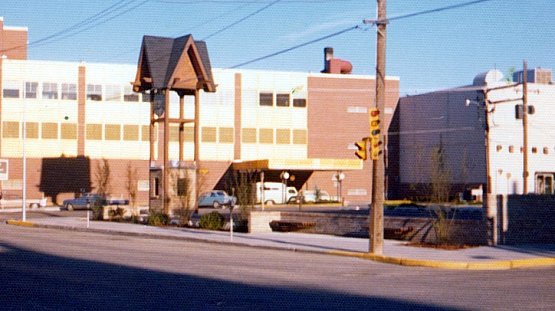
Lawrence at Fuller,
1970s; site of the old YMCA.
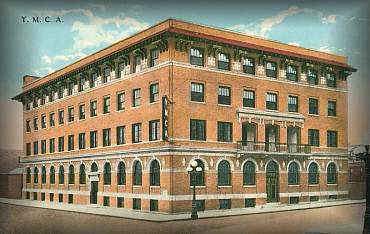
1914 view of the same corner.
|
|
|
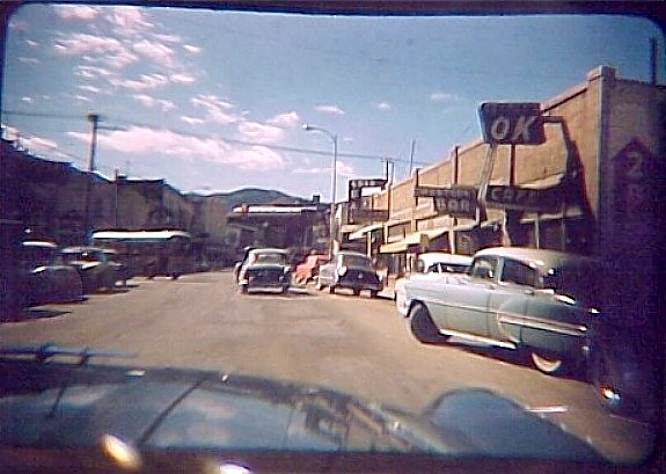
400 block of N.
Main, 1950s, looking south. Prominent in this rare view is George's
OK Cafe.

|
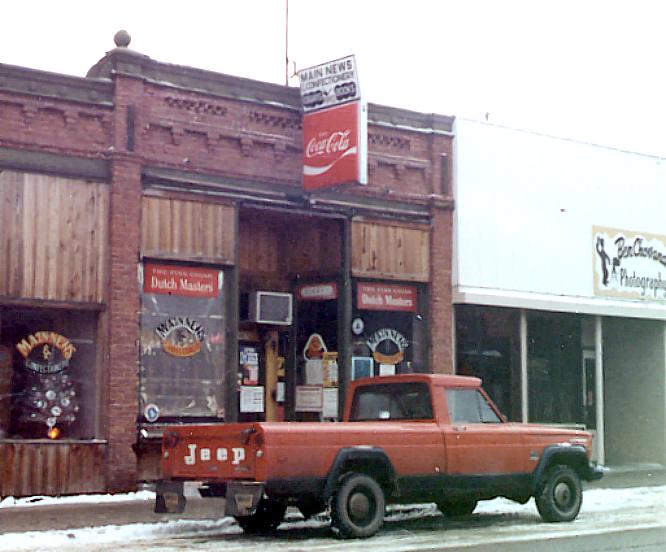
|
Main
News & Confectionery, 407 N. Main, 1980. COLLECTION
OF KENNON BAIRD
|
|
|
For many
years, Main News was operated by Mr. Harry Stone (1893 - 1972).
He stocked a wide variety of magazines, newspapers, comic books,
penny candy, pop, cigars, pipes, fishing reels, knives... You
could also get your fishing and hunting licenses there. It was
a wonderful place to go; indeed, it was a window to the outside
world, and also to the world of fantasy.
|
|
|

|
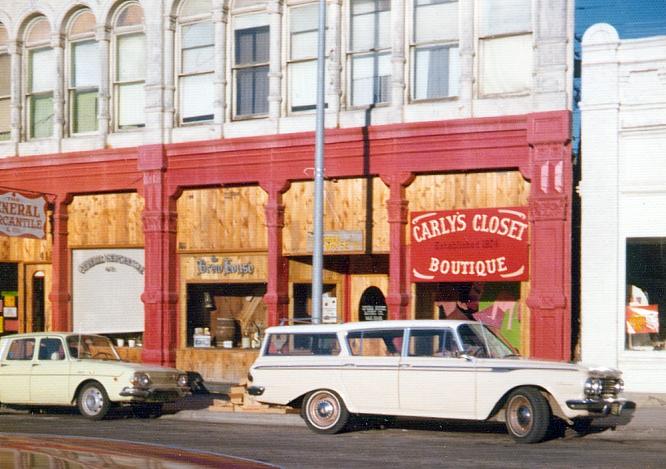
| Shops in
the 1888 Iron Front Building, 1970's. The iron façade was
cast at the Stedman Foundry, near the Kessler Brewery, west of
Helena. COLLECTION OF KENNON BAIRD |

|
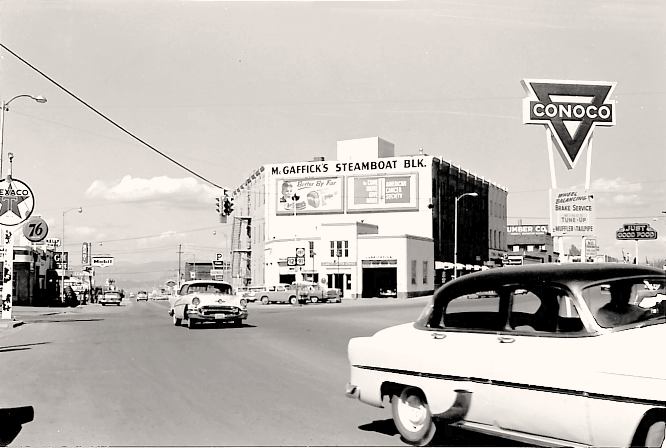
| N.
Main at Neill Ave., looking north, late 1950s. The Conoco station
was owned by Al Rose, who still has a garage in Helena. At far
right center is the "Just Good Food" sign for the Peter
Pan Drive Inn. Dominating the scene is the Steamboat Block, built
in the 1870s by shipping magnate and politician Thomas C. Power.
As evidenced by the period illustration below, the building has
been significantly altered. PHOTO
COURTESY OF DARCY O'DELL |
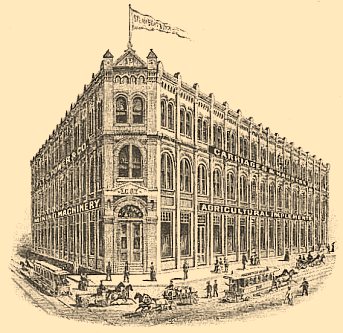
|


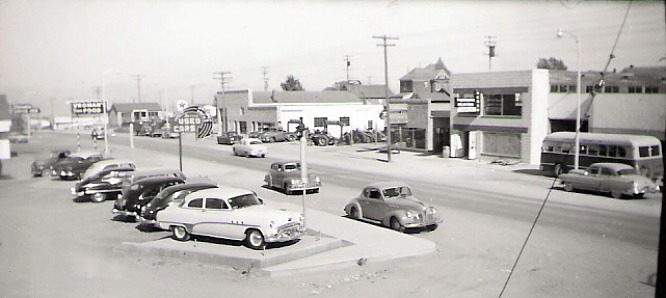
800 block
of N. Main, looking north, early 1950s. On the left is the Walt
Holland used car lot. On the right (east side) of Main, is Rock
Hand & Co., dealers in farm equipment and hardware.
THE COLLECTION OF NANCY GOODSPEED |

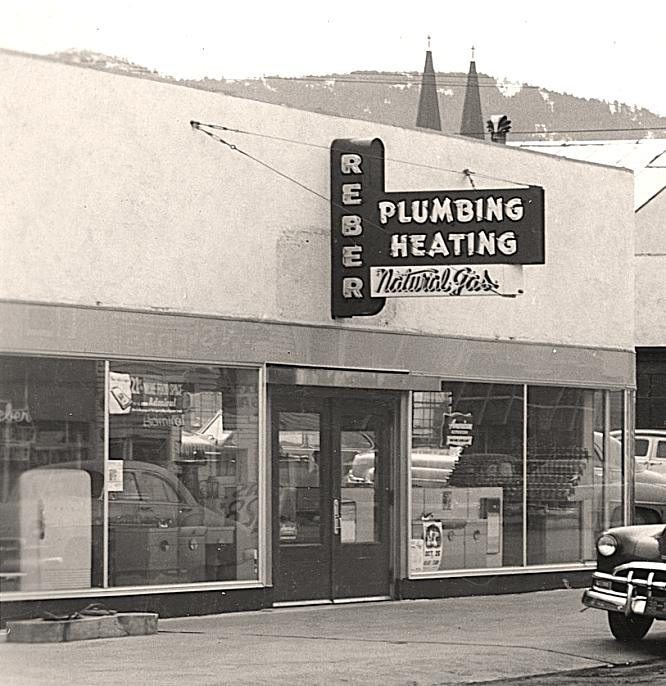
Reber Plumbing
& Heating Co., 805 N. Main, 1951.
COURTESY
OF KATHRYN FEHLIG

|
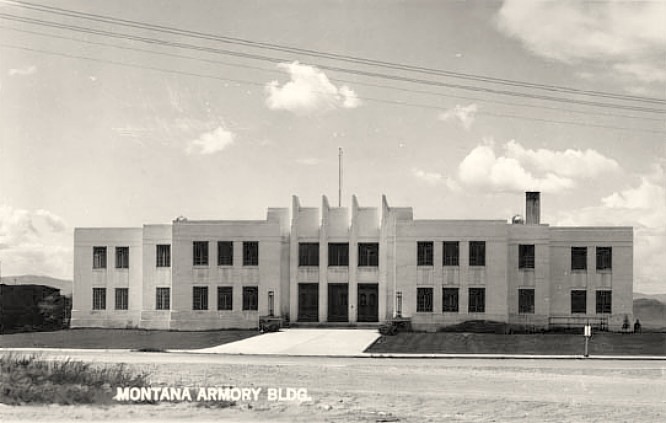
|
The 1942
Montana National Guard Armory, 1100 N. Last Chance Gulch at
Lyndale. Built to replace the Warren St. Armory which was destroyed
in the 1935 earthquakes, this building is now occupied by State
of Montana offices.
|
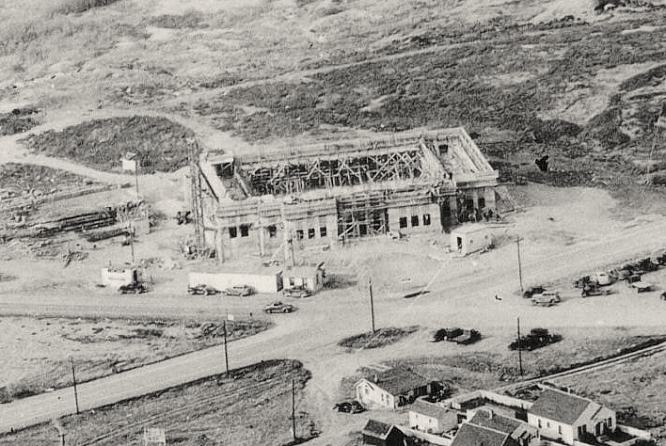
The Armory under
construction, 1942.
THE
WES AND CAROL SYNNESS COLLECTION
|
|
|
For many
years, traveling shows, such as the Siebrand Bros. Circus and
Carnival, would set up on the large open area behind the Armory.
In September of 1953, the Ringling Bros. and Barnum & Bailry
Circus set up their big top.
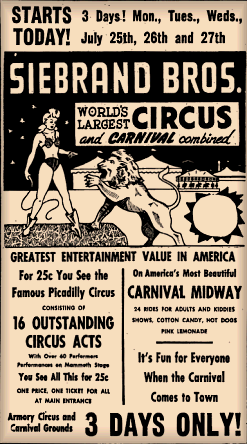

|
|
|

|

